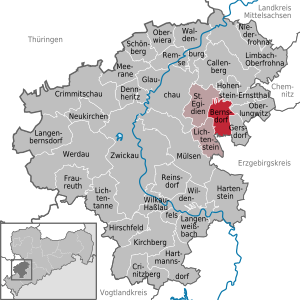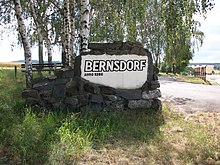Bernsdorf (Zwickau district)
| coat of arms | Germany map | |
|---|---|---|

|
Coordinates: 50 ° 46 ' N , 12 ° 40' E |
|
| Basic data | ||
| State : | Saxony | |
| County : | Zwickau | |
| Management Community : | Around the Auersberg | |
| Height : | 300 m above sea level NHN | |
| Area : | 14.82 km 2 | |
| Residents: | 2208 (Dec. 31, 2019) | |
| Population density : | 149 inhabitants per km 2 | |
| Postal code : | 09337 | |
| Primaries : | 037204, 03723 | |
| License plate : | Z, GC, HOT, WDA | |
| Community key : | 14 5 24 010 | |
| Community structure: | 3 districts | |
| Address of the municipal administration: |
Hauptstrasse 170 09337 Bernsdorf |
|
| Website : | ||
| Mayoress : | Roswitha Müller ( FDP ) | |
| Location of the municipality of Bernsdorf in the district of Zwickau | ||
Bernsdorf is a municipality in the district of Zwickau . It is part of the administrative community around the Auersberg based in Lichtenstein . The eponymous place dates back to 1286.
geography
location
The municipality of Bernsdorf is located in the Erzgebirge foothills , which reaches heights of 300 m in the municipality. Bernsdorf lies between Lichtenstein in the west and Oberlungwitz in the east and about 14 km east of the district town of Zwickau . The districts of Hermsdorf and Rüsdorf are in the valley of the Lungwitzbach , the main town Bernsdorf in the side valley of the Bernsdorfer Bach.
Neighboring places
| St. Egidien | Hohenstein-Ernstthal | |

|
Oberlungwitz | |
| Lichtenstein | Hohndorf | Gersdorf |
Community structure
The districts of Bernsdorf, Hermsdorf and Rüsdorf belong to the community .
history
The Waldhufendorf Bernsdorf was probably founded in the second half of the 12th century. However, the place was only mentioned as Bernstorf in the fragment of the Naumburg diocese register, which was created immediately after 1470 . In local history research, however, it is widespread that this matriculation was created as early as 1286 and therefore this year is incorrectly given as the year of first mention. The name of the place is said to be derived from the village of a Berno . In the 15th century the Hussites invaded Bernsdorf, and in 1613 the plague claimed numerous lives among the inhabitants. The Thirty Years War destroyed more people and houses. In 1656 there is a report about the persecution of witches in Bernsdorf: The gardener Johann Schulze got into a witch trial . Regarding the manorial belonged Bernsdorf as office Village for nice burg rule Lichtenstein . The local peasants took part in the 1661 uprising against the Fron of the Schönburg rule in Lichtenstein and were defeated. The Seven Years' War and subsequent storms and famines threatened the people of Bernsdorf. Several famous personalities such as ETA Hoffmann , Heinrich von Kleist and King Anton the Kind of Saxony traveled through Bernsdorf in the 18th and 19th centuries.
After an administrative reform was carried out in the area of the Schönburg recession in 1878, Bernsdorf came to the newly founded Saxon governorate of Glauchau in 1880 . Between 1902 and 1918, Bernsdorf was completely connected to the electrical supply and has had electrical street lighting ever since. After the First World War the village administration needed its own town hall, for which purpose the former church school was expanded. In 1928 there was a connection to a public drinking water supply in the entire village. During the Nazi era , Rüsdorf and Bernsdorf merged on June 1, 1936 . Towards the end of this period, when the Second World War had returned to Germany, prisoner death marches led through Bernsdorf and Rüsdorf in the spring of 1945 . On April 18, American troops reached Bernsdorf and entered without a fight. Due to the occupation zones previously agreed between the Allies, the Americans were exchanged for Red Army troops on June 14, 1945 .
As a result of the second district reform in the GDR , the municipality of Bernsdorf with Rüsdorf came to the Hohenstein-Ernstthal district in the Chemnitz district in 1952 (renamed the Karl-Marx-Stadt district in 1953 ). During the GDR period, a cultural life developed in Bernsdorf. First a pioneer orchestra was founded (today it is run as a youth wind orchestra), and in 1986 an open-air stage was inaugurated. As a tourist highlight, the district administration provided a discarded TU 134 aircraft for inspection on the occasion of the 700th anniversary celebration - the year 1286 served as the basis for this anniversary . The reorganization of the federal states after the fall of the Wall also meant that administrative changes had to be implemented. From 1990 the municipality of Bernsdorf belonged to the Saxon district of Hohenstein-Ernstthal , which became part of the Chemnitzer Land district in 1994 and the Zwickau district in 2008. On August 1, 1994, Hermsdorf was incorporated into Bernsdorf. Two devastating flood disasters hit the community with its districts in 2002 and 2004, bridges and roads were severely damaged. Bernsdorf celebrated its 725th anniversary in 2011 with a number of festive activities.
History of the village church
About the history of under princely patronage reign of Schönburg-Waldenburg seasoned church are as good as before any information. It stands in the middle of the village, on a hill. Its pointed tower is 46 m high. After the construction of its individual parts, the construction is dated to the Middle Ages . The Reformation was introduced in Bernsdorf in 1542. The church has three chime bells , which are hung one above the other in the tower, and a chiming bell belonging to the clock. The big bell dates from 1521. It was cast in the Freiberg workshop of the bell and gun founder Martin Hilliger (1484–1544). The middle bell has its origin around 1400 and is considered a thunder and storm bell. It had to be cast in 1941 because in 1941 a crack ran over the entire bell. The casting was carried out by the company Franz Schilling and Sons from Apolda . At the same time, a small sound bell was re-cast. It was privately commissioned by the local manufacturer Horst Pfotenhauer from the same company. This happened because the small bell from 1817, cast by Johann Gottlieb Hellmuth from Zwickau , was shipped to the smelter on December 10, 1941, on behalf of the Reichsstelle für Metallle in Berlin. As if by a miracle it was spared the meltdown and was found again in 1949 in the bell camp near Hamburg . On Christmas Day 1949 the parish celebrated its return with the entire village. Since the said manufacturer had in the meantime had a new bell cast, the returned bell found a new place near the clock and is still used today as a chiming bell. All bells were cast from bronze.
There are two treasures inside the church. On the one hand the altar with the depiction of the Holy Communion. This is a valuable wood carving work, made by Christian Spohr from Lößnitz . Another treasure is a life-size crucifix by the most important late Gothic carver in Saxony, Peter Breuer (1472 / 73-1541). This work is dated from around 1520. The first organ has existed since 1743. Over a hundred years later, in 1856, the organ builder Jehmlich from Zwickau received the order to build a completely new organ. The completion took place in the year 1859. A general overhaul began on January 2nd, 1995 by the company Eule Orgelbau in Bautzen and ended with the re-inauguration on December 10th (1st Advent) 1995.
Population development
On October 3, 1990, Bernsdorf had 2,474 inhabitants. The following population figures refer to December 31 of the previous year:
|
1998 to 2002
|
2003 to 2007
|
since 2008
|
- Source: State Statistical Office of the Free State of Saxony
politics
Municipal council
Distribution of seats
Since the municipal council election on May 25, 2014 , the 14 seats of the municipal council have been distributed among the individual groups as follows:
- CDU : 9 seats
- FDP : 3 seats
- Local voters' association Freundeskreis Jugendblasorchester Bernsdorf (KWV JB): 2 seats
Buildings

half-timbered house in Bernsdorf
- Village church
- town hall
- Building of the former stocking factory (1923) on Dresdner Strasse
traffic
The federal highway 173 crosses Bernsdorf in an east-west direction. The federal road 180 forms the north-western border of the municipality and leads from the Hohenstein-Ernstthal junction of the A 4 to the A 72 with the Stollberg-West junction .
The nearest train stations are Hohenstein-Ernstthal and St. Egidien on the Dresden – Werdau railway and Lichtenstein (Sachs) on the Stollberg – St. Egidien .
Sons and daughters of the church
- Otto Delitsch (1821–1882), theologian, geographer
- Wilhelm Bahner (1854–1919), entrepreneur in Hermsdorf (Wilhelm Friedrich Bahner) and conservative politician, Member of the State Parliament
- Max Ernst Opitz (1890–1982), local politician (SED), 1949–1951 Lord Mayor of Leipzig
- Gerhard Thieme (1928–2018), sculptor
- Volker Bigl (1942–2005), physician and neuroscientist, holder of the Federal Cross of Merit 1st Class of the Order of Merit of the Federal Republic of Germany
- Gottfried Klimbt (1935–2016), track and field athlete
See also
literature
- Richard Steche : Bernsdorf . In: Descriptive representation of the older architectural and art monuments of the Kingdom of Saxony. 13. Issue: Glauchau District Authority . CC Meinhold, Dresden 1890, p. 4.
- Wolf-Dieter Röber: "Unknown views of castles and outbuildings on a Schönburg family tree" (probably created around 1760), In: Series of publications "Heft 3", publisher: Museum und Kunstsammlung Schloß Hinterglauchau: Stadt Glauchau, 1981, GDR, p. 20 u. 38 (Description and illustration of the lost Rüsdorf / Rüßdorf Castle (near Bernsdorf and Lichtenstein) owned by the Lords of Schönburg )
Web links
- Bernsdorf in the Digital Historical Directory of Saxony
Individual evidence
- ↑ Population of the Free State of Saxony by municipalities on December 31, 2019 ( help on this ).
- ^ Documents of the Margraves of Meissen 948-1099, Excurs II , last accessed on March 9, 2010
- ↑ a b c d e f history of Bernsdorf in the Erzgebirge; Timeline ; accessed on March 1, 2015.
- ↑ Manfred Wilde : The sorcery and witch trials in Kursachsen , Cologne, Weimar, Vienna 2003, p. 541.
- ↑ Handbook of Geography, p. 510
- ^ Bernsdorf in the book "Geography for all Stands", p. 900
- ^ Karlheinz Blaschke , Uwe Ulrich Jäschke : Kursächsischer Ämteratlas. Leipzig 2009, ISBN 978-3-937386-14-0 ; P. 92 f.
- ↑ The Glauchau administrative authority in the municipal register 1900
- ^ Rüsdorf on gov.genealogy.net
- ↑ Hermsdorf on gov.genealogy.net
- ↑ Results of the 2014 municipal council elections







